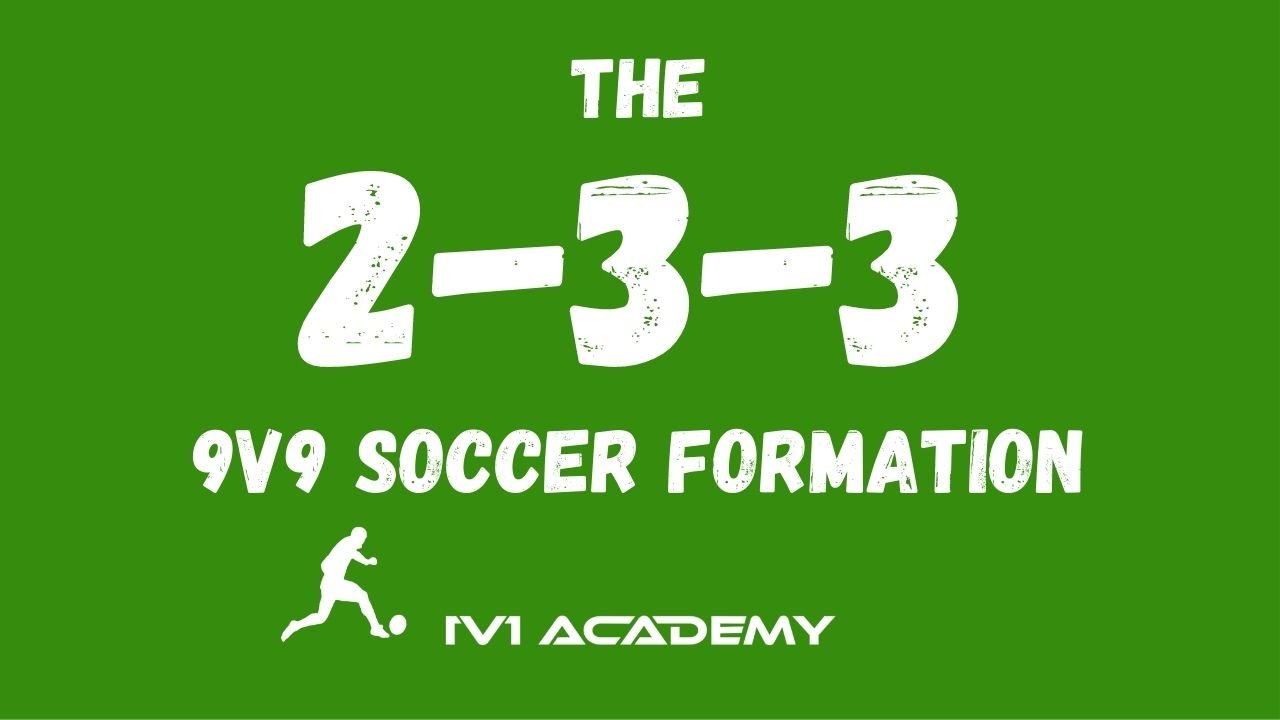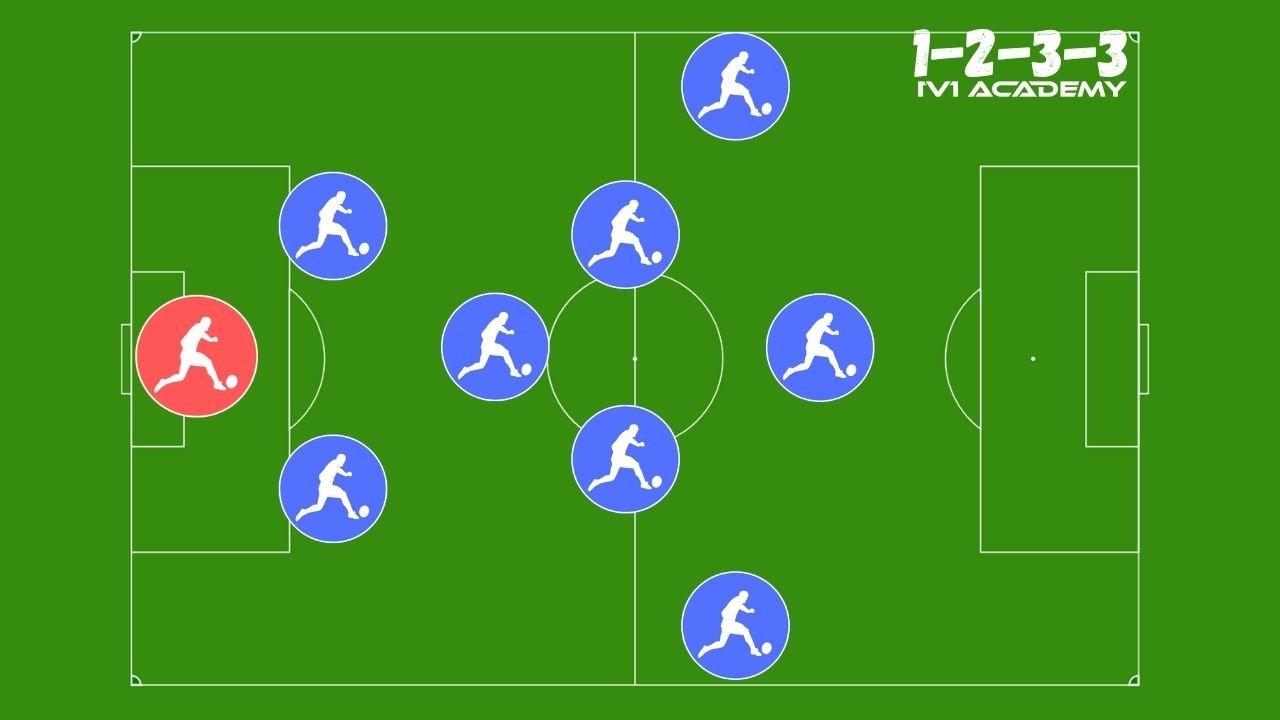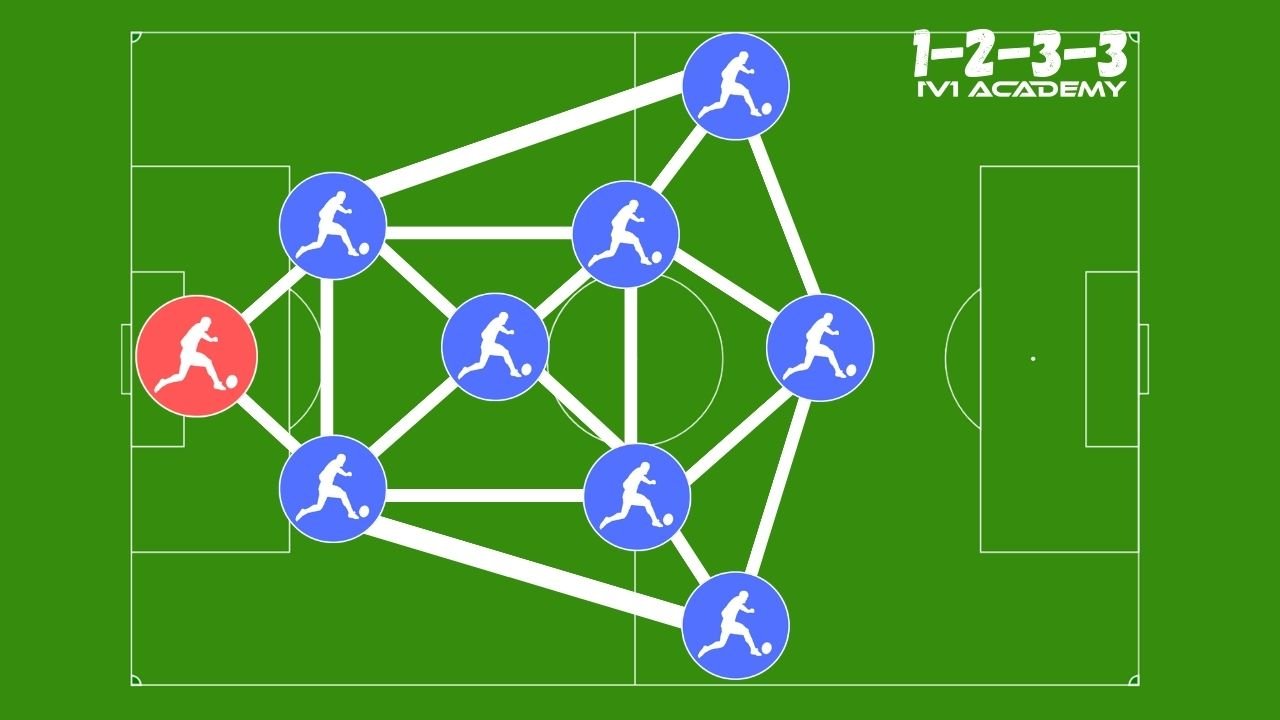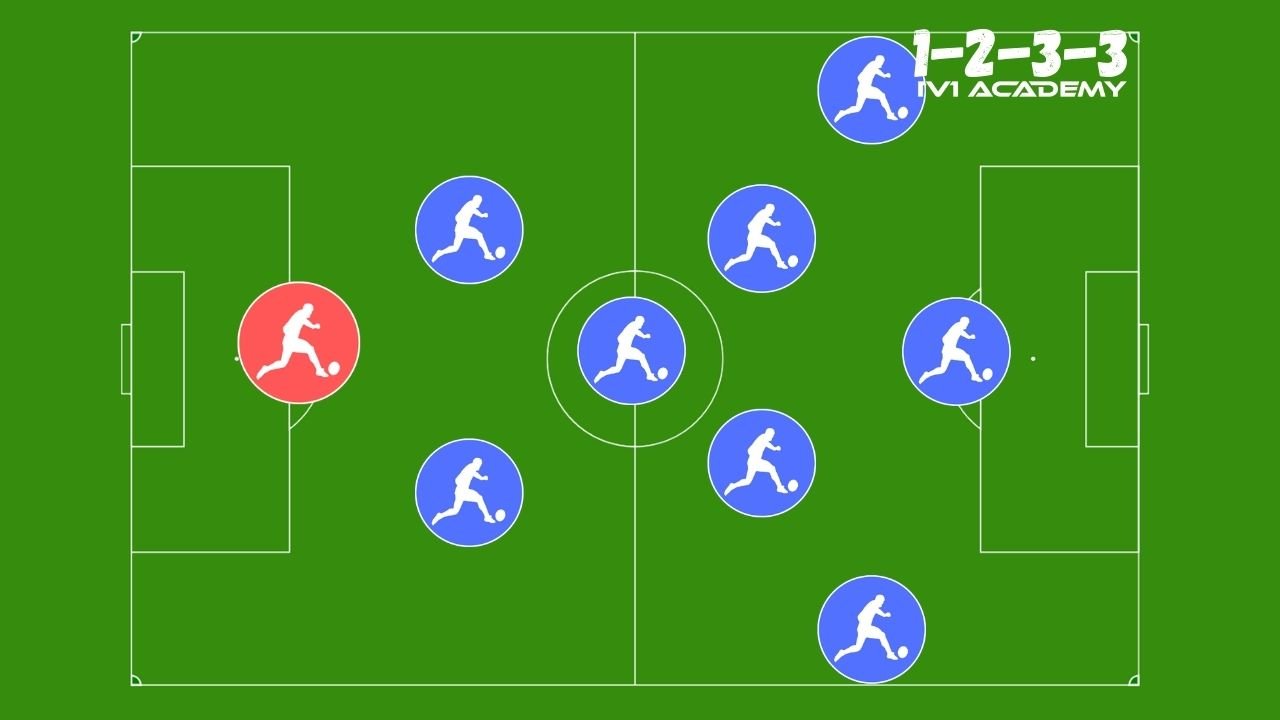
Play to listen to the article.
By Rudy Glez
1v1Academy. An Online Soccer Academy
A Guide for Success. Unleashing the Power of the 2-3-3 Soccer Formation.
Are you ready to take your soccer team’s performance to the next level? Look no further than the dynamic and exciting 2-3-3 soccer formation! We will explore how this formation works, strategies to implement, and tips to customize it for your team’s unique strengths. Let’s dive in and unlock your team’s winning potential!
What is the 2-3-3 Soccer Formation?
The 2-3-3 soccer formation is a tactical arrangement consisting of one goalkeeper, two defenders, three midfielders, and three forwards. This formation perfectly balances solid defensive coverage and an explosive attacking force.

How does the 2-3-3 Soccer Formation Work?
With two defenders, your team can maintain a sturdy defensive foundation. They act as a shield, protecting the goal and thwarting the opponent’s advances. The three midfielders bridge the gap between defense and offense, providing support to both ends. Finally, the three forwards create chaos and turmoil for the opposing team’s defense, keeping them on their toes.
Implementing the 2-3-3 Soccer Formation with Your Team:
To successfully implement the 2-3-3 soccer formation, clear communication and teamwork are essential. Assign roles to each player, emphasizing their specific responsibilities and positions on the field. Encourage your players to develop a strong understanding of their teammates’ movements and tendencies.
Strategies for Success:
- Fluid Passing and Quick Transitions: Encourage your midfielders to be the engines of the team, constantly moving and linking up with both the defenders and forwards. Quick and accurate passing will disrupt the opponent’s defense and create scoring opportunities.
- Overlapping Runs and Wing Play: Utilize the width of the field by instructing your full-backs to make overlapping runs and provide width in the attack. This creates space for the midfielders and forwards to exploit, putting pressure on the opposing defense.
- High Pressing: Implement a high-pressing strategy to regain possession quickly. This involves your forwards and midfielders aggressively pressuring the opposing team, forcing turnovers and creating counter-attacking opportunities.
Adapting the 2-3-3 Soccer Formation:
No team is the same, so it’s essential to adjust the 2-3-3 soccer formation to fit your team’s unique strengths and weaknesses. Assess the skill set and playing styles of your players and make modifications accordingly. Flexibility is the key to success!
The 2-3-3 soccer formation offers an exhilarating and dynamic style of play that can revolutionize your team’s performance. Embrace the power of this formation, communicate effectively, and implement proven strategies to unlock your team’s full potential. Get ready for a thrilling journey on the soccer field, filled with victories and unforgettable moments!

When to Use the 2-3-3 Soccer Formation Against Other 9v9 Formations
Against 2-4-2: When facing a balanced 2 4 2 formation, the 2-3-3’s midfield mastery comes into play. The lone midfielder disrupts the equilibrium, outclassing the opponent’s midfield duo and paving the way for your attacking trio.
Against 3-2-3: When confronted with a formation boasting a two man midfield presence like the 3-2-3, the 2-3-3 maintains its dominance. The two defenders act as a defensive shield, while the three midfield orchestrator battles the rival midfield, tipping the balance in your favor.
Against 2-1-4: When your opponents adopt an aggressive 2-1-4 formation, the 2-3-3’s defensive solidity shines. The two defenders create a robust backline, thwarting attacks, and allowing your forwards to exploit the spaces left by the opponent’s aggressive setup.
In Closing Moments: When every second counts, and victory hangs in the balance, the 2-3-3 becomes your winning card. Tighten the defense, let the midfielder dictate the game, and watch your forwards sprint towards glory.
When to Use the Dominant 2-3-3 Soccer Formation
The 2-3-3 soccer formation can be a game-changer when used strategically. But when should you deploy it? Let’s dive into the recommendations that will help you make the most of this powerful formation.
- Attacking Firepower: If your team boasts talented forwards who possess lightning-fast speed and excellent finishing abilities, the 2-3-3 formation is perfect. It allows them to cause chaos and havoc on the opponent’s defense.
- Midfield Mastery: When your midfielders are creative playmakers, adept at controlling the tempo and dictating the flow of the game, the 2-3-3 formation can optimize their skills. They will be the engine of your team’s success.
- Versatile Defenders: Utilize the 2-3-3 formation when your defenders are versatile, capable of confidently handling defensive duties while also providing support in attack. Their adaptability will be key to the team’s success.
- Emphasis on Possession: If your team excels at maintaining possession and building up play patiently, the 2-3-3 formation can work wonders. The three midfielders ensure control and provide passing options in various areas of the field.
- Strong Offensive Mindset: When your team thrives on attacking prowess and constantly seeks to score goals, the 2-3-3 formation is an ideal choice. It emphasizes an aggressive mindset and puts relentless pressure on the opposition.
- Quick Counterattacks: Utilize the 2-3-3 formation if your team excels at capitalizing on quick counterattacks. With the three forwards leading the charge, they can exploit spaces left by the opponent’s defense.
- Flexibility and Adaptability: The 2-3-3 formation is highly adaptable, making it suitable for teams that have versatile players capable of playing multiple positions. This allows for seamless transitions and adjustments during the game.
- Youthful Energy: If you’re coaching a youth team with energetic and enthusiastic players, the 2-3-3 formation can harness their energy effectively. It encourages movement, creativity, and the joy of attacking play.
Remember, the 2-3-3 soccer formation is not a one-size-fits-all solution. Consider your team’s strengths, playing style, and the specific demands of each match before implementing this formation. Use it wisely, and watch your team soar to new heights!

When to Avoid the 2-3-3 Soccer Formation, Making the Right Decision for Your Team
While the 2-3-3 soccer formation can be highly effective, there are situations when it may not be the best fit for your team. Consider the following recommendations to determine when to avoid using this formation based on your players’ capabilities.
- Weak Defensive Line: If your team lacks strong defenders who can confidently handle defensive responsibilities, it’s best to avoid the 2-3-3 formation. A vulnerable defense could leave your goal exposed to counterattacks.
- Limited Midfield Depth: When your team has a scarcity of midfielders who possess the necessary skills and endurance to cover the midfield area effectively, consider alternative formations that provide more midfield support.
- Inconsistent Forward Play: If your forwards struggle with consistency in their finishing abilities or lack the speed to exploit the opposition’s defense, it might be wise to explore formations that offer more support upfront.
- Defensive-Minded Approach: When your team’s primary focus is on a solid defense and prioritizing clean sheets, the 2-3-3 formation may not align with your tactical philosophy. Explore formations that prioritize defensive stability.
- Lack of Speed and Stamina: If your players lack the necessary speed and stamina to maintain the intensity of the 2-3-3 formation throughout the match, consider formations that require less running and offer more positional structure.
- Youth or Inexperienced Team: For youth or inexperienced teams still developing their skills and understanding of the game, the 2-3-3 formation may be overwhelming. Choose formations that provide more structure and simplify player roles.
- Opponent’s Dominant Midfield: When facing a team with a strong and dominant midfield, the 2-3-3 formation might leave your midfield outnumbered and overrun. Opt for formations that provide additional cover in midfield.
- Adverse Weather Conditions: In challenging weather conditions, such as strong winds or heavy rain, the 2-3-3 formation may not be ideal. Choose formations that offer more stability and control in unpredictable circumstances.
The key to success is understanding your team’s capabilities and selecting the formation that maximizes their strengths while mitigating weaknesses. By making educated decisions, you can make sure your team’s performance remains at its peak.
In conclusion, the 2-3-3 soccer formation offers an exhilarating blend of attacking prowess and midfield control. To unlock the full power of this formation and enhance your knowledge, delve into the comprehensive learning content provided by 1v1 Academy. From tactical insights to skill development techniques, their resources are designed to elevate both players and coaches.
Take action now and embark on a journey of growth and success. Follow 1v1 Academy on social media to stay updated on their latest tips, tricks, and strategies. Make sure you seize the opportunity to broaden your knowledge and achieve your soccer aspirations.
Remember, the game is ever-evolving, and continuous learning is the key to staying ahead. Equip yourself with the knowledge and skills offered by 1v1 Academy and make your mark on the soccer field. Seize the opportunity today – The ball is in your court!
1v1Academy. An Online Soccer Academy
